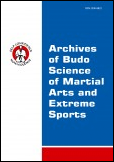2018, Volume 14, Issue 1
Perkal’s natural indicators method in assessing body composition properties in persons practising combat sports – an analysis research results
Władysław Jagiełło1, Marcin Dornowski1, Marin Jagiełło1
1Department of Sport, Gdansk University of Physical Education and Sports, Gdansk, Poland
Author for correspondence: Władysław Jagiełło; Department of Sport, Gdansk University of Physical Education and Sports, Gdansk, Poland; email: wjagiello1@wp.pl
Full text
Abstract
Background & Study Aim: Contemporary scientific research confirms the fact that the body composition is one of the elements distinguishing athletes from persons not practicing sports systematically. Scientists mostly describe the body composition through various typological systems. Among the many typologies used in anthropology, the most widely used is Sheldon’s somatotypology (1940), in Heath and Carter’s modification (1967). Perkal’s method of natural indicators (1953) is also a very interesting but unfortunately little-known in the world method of evaluating the body composition. In this context, the main research objective was to review studies on the assessment of body composition in combat sports using Perkal’s natural indicators method. An additional goal was also recommendation of scientists involved in athletes’ body composition qualities to the great advantages of this method.
Material & Methods: The basic method of research was an analysis of available literature which covered a period of ten years (2007-2017).
Results: The study found that articles related to the discussed issue were published in six journals. In total, it was 8 articles, the most in Archives of Budo (n = 4) and each remaining in a different journal. This research involved 104 Polish representatives in five sport disciplines.
Conclusions: Because Perkal’s natural indicators are calculated from the values of the standardised features (standardised results), this gives a possibility to express all the characteristics in the same and thus comparable values of the same "weight". This opens up opportunities which other typological systems do not offer. It leaves a freedom of choice of such characteristics of which we know that they are of great importance in a particular sport discipline or whose usefulness we want to verify.
Key words: Sheldon’s somatotypology, standardised results, typological systems





